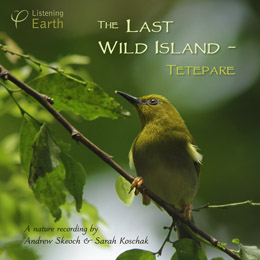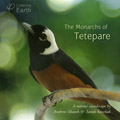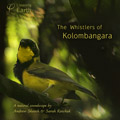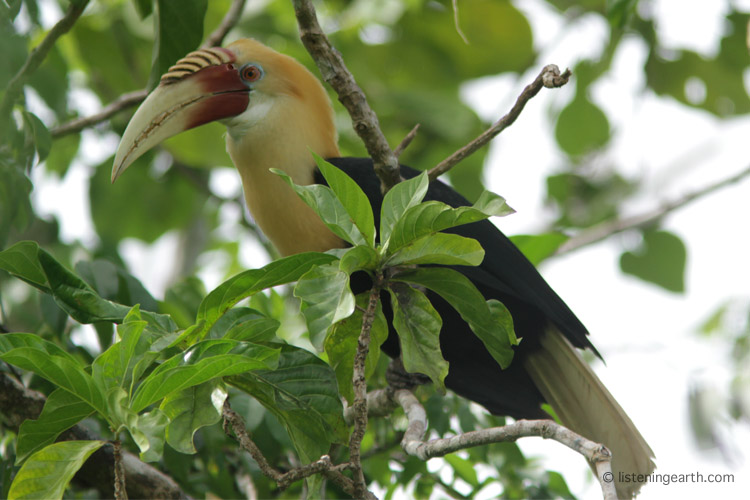

Running Time:
80 min
Release Date:
March 2015
Recording Location:
Tetepare Island, Solomon Islands, Western Pacific
If you like this album,
we also recommend:
The Last Wild Island - Tetepare
Tetepare is a wilderness island of the Solomons group in the western Pacific. It is entirely covered in primary rainforest, and one of the few places where the biodiversity of this region can be found and heard intact. Elsewhere throughout the Solomons, timber companies have stripped the forests to the detriment of not only the ecosystems and surrounding reefs, but often the livelihood of traditional peoples. Tetepare is sadly the last, truly wild island.
We begin listening as surf breaks on the barrier reef that surrounds the island. Then, in the darkenss before dawn, we move into the primary rainforest itself. Kingfishers, megapodes, cuckoos, owls, insects and horned frogs call in dark. The ethereal piping of monarchs signals the coming dawn, and with it are heard the soft songs of the island's endemic white-eyes.
Later, the forest presents a diversity of tropical birdsong; metallic starlings feed nearby, lorikeets screech as they wing overhead, mynas whistle richly, singing parrots and ducorp's cockatoos utter melodious cries, fruit pigeons boom deeply, while cicadas chorus in gentle waves. The sounds of two species are especially remarkable; the un-bird-like growls of buff-breasted coucals, and the calls of magnificent blythe's hornbills as they move around the forest on heavy wingbeats.
Listening notes for this album may be downloaded here.
Andrew comments:
Sarah and I spent ten days on the island making this recording, accompanied by our local guide, Twomey. One of the highlights for us was coming across the extraordinary early dawn singing of the white-capped monarchs. We've made their ethereal songs into a separate album, The Monarchs of Tetepare.
That Tetepare has been preserved as a sanctuary is the result of vision and hard work on the part of the islanders themselves. A visiting Australian couple, both ecologists, supported them in this enterprise, and Dr. John Read has recently written the story of their combined efforts to save the island. John describes the ecology of the island with warmth and passion, and we recommend his book as a natural companion to this recording. Links to purchase:
Amazon: Kindle edition
Amazon: Paper edition
Page Publishing, digital and print editions
John Read's website
Tetepare Island Eco Lodge website
Audio sample of this album
|
1. |
Distant Reef at Night |
3.17 |
|
2. |
Into the Forest Before Dawn |
11.23 |
|
3. |
Daylight Comes to Tetepare |
14.59 |
|
4. |
Tetepare's Primary Rainforest |
31.33 |
|
5. |
Blythe's Hornbills and Buff-breasted Coucals |
18.41 |
Purchase this
album as:
Digital Album
(for immediate download)
Download this album
for as little as
$7.50 -
View Special Deals
(Prices AU$, exGST)
Mp3:
Mp3 is a universal audio format, playable on iPods, computers, media players and mobile phones.
Mp3 is a compressed format, allowing smaller filesizes, offering faster download times and requiring less storage space on players, but at some expense to the audio quality. Many listeners can't really hear the difference between mp3 and full CD-quality audio, and hence its convenience has lead to it becoming the default option for audio.
Our albums are generally encoded at around 256kbps (sometimes with VBR), balancing optimal audio quality without blowing out filesizes excessively. We encode using the Fraunhoffer algorithm, which preserves more detail in the human audible range than the lame encoder.
Our mp3 files are free of any DRM (digital rights management), so you can transfer them to any of your media technology. You've paid for them, they're yours for your personal use without restriction.
Mp3 files can be burned to disc, either as an mp3 disc, or an audio CD after converting them to a standard audio (.wav or .aif) format first.
FLAC:
FLAC is a high-quality audio format, allowing CD-resolution audio. It is ideal if you wish to burn your files to a CDR, or listen over a high resolution audio system. However files usually require special decoding by the user before playing or burning to disc.
FLAC (Free Lossless Audio Codec) is a LOSSLESS compressed audio format. This means that it preserves the full audio quality of a CD, but optimises the filesize for downloading. Typically, file sizes of around 60% are achieved without any degradation or loss of audio quality from the source files at the CD standard of 16bit/44.1kHz.
Obviously the file sizes are larger than for the mp3 version - usually around 300-400Mb for an album, compared to 100Mb for an mp3 album.
In addition, you'll need to know what to do with the files once you've downloaded them. In most cases you'll want to decode the files to wav or aiff, either to import into programs like iTunes, or burn to CDR. Some programs will play flac files natively.
There is a lot of information about flac online (eg: http://flac.sourceforge.net/)





 Alternate audio link
Alternate audio link 